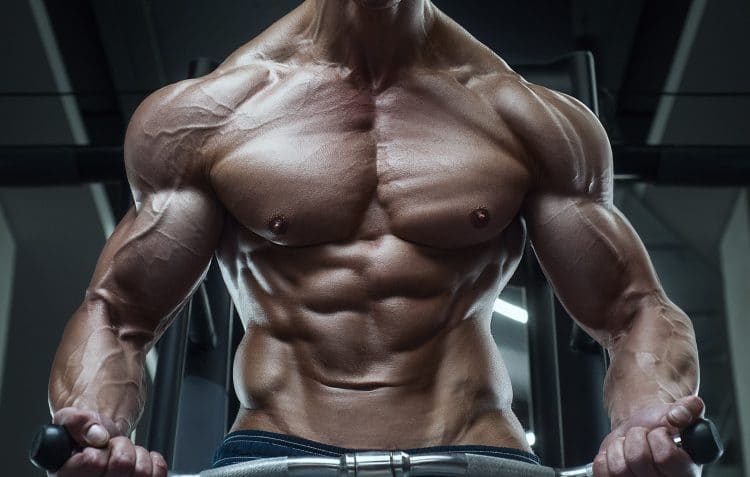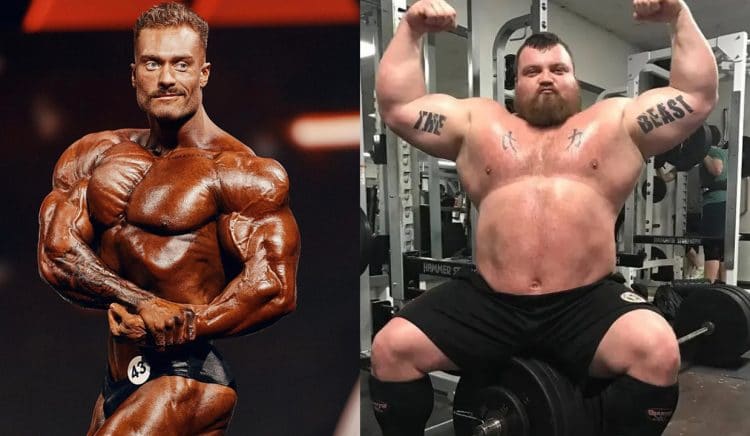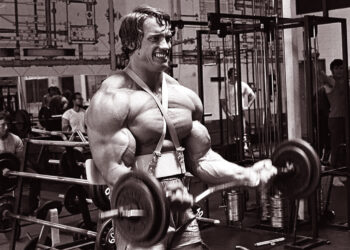Most exercisers don’t want big, soft muscles; they want hard muscles that are defined and dense. It’s the difference between looking like a strongman and an in-season bodybuilder. Both have large muscles, but where the bodybuilder looks like he’s carved from granite, with each muscle clearly visible, the strongman is just massive.
Now, before you start yelling that not all powerlifters are fat and undefined, understand that it’s true often enough that it’s still a valid statement. Yes, there ARE exceptions, but bodybuilders are generally leaner than their powerlifting counterparts.
Dense, lean muscle doesn’t happen by accident. It takes a combination of diet and training to take soft-looking muscles and make them hard. Also, muscle density tends to develop with age. That’s why a lot of older bodybuilders still look rock-hard.
Diet-wise, you’ll need to eat less to force your body to start burning fat for fuel. As your body fat percentage declines and your body composition improves, you’ll begin to lose the intramuscular fat that makes your muscles look soft and undefined. However, you’ll also need to avoid losing muscle, or you won’t look as dense.
It’s beyond the scope of this article to tell you how to eat for fat loss and muscle density, but here are some resources to get you started:
Level Up Your Fitness: Join our 💪 strong community in Fitness Volt Newsletter. Get daily inspiration, expert-backed workouts, nutrition tips, the latest in strength sports, and the support you need to reach your goals. Subscribe for free!
- Cutting Diet Plan to Shred Fat Fast
- Weight Loss Calculator
- A Complete Guide to Understanding Thermic Foods
- Lean Body Mass Calculator
- 6 Ways to Boost Your Metabolism and Burn Fat
With your diet (hopefully!) taken care of, in this article, we’re going to provide you with a workout designed to increase muscle density, banishing soft muscles for good!
Workout for Muscle Density
Look at most bodybuilding workouts, and you’ll see that they use the same rep range for all the exercises, usually something like 8-12 reps. Historically, this rep range is associated with muscle hypertrophy and provides a reasonable compromise between lifting heavy weights for low reps and light weights for high reps. 8-12 reps is right in the middle.
However, doing all your sets in this rep range means you are essentially hitting the same muscle fibers over and over again, which could mean that your workout is not as effective as it could be.
If you want to develop all your muscle fibers so your muscles are as hard and dense as possible, using a range of reps may produce better results. After all, you use different exercises to work your muscles from various angles, so why not also use several rep ranges to target the different muscle fibers.
This workout is based on the ideas of Fred (Dr. Squat) Hatfield, who presented this holistic training approach in his book “Bodybuilding: A Scientific Approach.”
Fred Hatfield, at the grand old age of 45 and weighing just 245lbs, was the first man to squat over 1000lbs. Known for his precise, detail-orientated approach to training, it’s safe to say Dr. Squat knew a thing or two about building muscle size.
Here’s your weekly training split:
| Mon | Tue | Wed | Thu | Fri | Sat | Sun |
| Chest | Back | Shoulders | Rest | Legs | Arms | Rest |
Before each workout, take a few minutes to warm up and prepare your body for what you are about to do. Start with 5-10 minutes of easy cardio followed by some dynamic mobility and flexibility exercises for the body part(s) you are going to train. Finish your warm-up with a couple of progressive sets of your first 1-2 exercises.
Each workout starts with a key exercise that you will do for six sets – two heavy, two medium, and two light.
Level Up Your Fitness: Join our 💪 strong community in Fitness Volt Newsletter. Get daily inspiration, expert-backed workouts, nutrition tips, the latest in strength sports, and the support you need to reach your goals. Subscribe for free!
After, you’ll hit that muscle again using the same heavy/medium/light sequence but with different exercises to work the target body part from a range of angles.
Try to reach failure within the prescribed repetition ranges and increase your weights week by week as you get stronger.
Workout 1 – Chest

Your first muscle density workout starts with bench presses. Do two heavy sets of 3-5 reps, two medium sets of 10-12 reps, and then two light sets of 15-20 reps. Afterward, you’ll do three sets of heavy incline bench presses, three medium sets of dips, and three light sets of pec deck. Bring your workout to a close by pumping out 100 push-upsin as few sets as possible.
Chest Workout for Muscle Density
| Exercise | Sets | Reps | Recovery | |
| 1 | Bench press (heavy) | 2 | 3-5 reps | 2-3 minutes |
| 2 | Bench press (medium) | 2 | 10-12 reps | 60-90 seconds |
| 3 | Bench press (light) | 2 | 15-20 reps | 30-60 seconds |
| 4 | Incline bench press | 3 | 3-5 reps | 2-3 minutes |
| 5 | Dip | 3 | 10-12 reps | 60-90 seconds |
| 6 | Pec deck | 3 | 15-20 reps | 30-60 seconds |
Workout 2 – Back

Today’s back workout follows the same format as yesterday’s chest session. Your finisher is 50 pull-ups or chin-ups in as few sets as possible. Too tired for pull-ups or chin-ups? Use an assisted pull-up/dip machine.
Back Workout for Muscle Density
| Exercise | Sets | Reps | Recovery | |
| 1 | Lat pulldown (heavy) | 2 | 3-5 reps | 2-3 minutes |
| 2 | Lat pulldown (medium) | 2 | 10-12 reps | 60-90 seconds |
| 3 | Lat pulldown (light) | 2 | 15-20 reps | 30-60 seconds |
| 4 | Pendlay row | 3 | 3-5 reps | 2-3 minutes |
| 5 | Seated cable row | 3 | 10-12 reps | 60-90 seconds |
| 6 | Single-arm dumbbell row | 3 | 15-20 reps | 30-60 seconds |
Workout 3 – Shoulders
You should be getting familiar with this training format by now; it’s two heavy, two medium, and two light sets of shoulder presses followed by three heavy, medium, and light sets of three more shoulder exercises. Finish off your shoulders with 100 reps of band pull-aparts in as few sets as possible.
Shoulder Workout for Muscle Density
| Exercise | Sets | Reps | Recovery | |
| 1 | Barbell shoulder press (heavy) | 2 | 3-5 reps | 2-3 minutes |
| 2 | Barbell shoulder press (medium) | 2 | 10-12 reps | 60-90 seconds |
| 3 | Barbell shoulder press (light) | 2 | 15-20 reps | 30-60 seconds |
| 4 | Seated dumbbell shoulder press | 3 | 3-5 reps | 2-3 minutes |
| 5 | Dumbbell lateral raise | 3 | 10-12 reps | 60-90 seconds |
| 6 | Face pull | 3 | 15-20 reps | 30-60 seconds |
Workout 4 – Legs
Probably the most challenging workout of the week, today is leg day. Because the legs are made up of several muscles, there are some additional exercises in this workout. For exercises 7, 8, and 9, do one heavy, one medium, and one light set of each. Finish off with 100 reps per leg of bodyweight-only lunges. Walking lunges are also acceptable.
Leg Workout for Muscle Density
| Exercise | Sets | Reps | Recovery | |
| 1 | Back squat (heavy) | 2 | 3-5 reps | 2-3 minutes |
| 2 | Back squat (medium) | 2 | 10-12 reps | 60-90 seconds |
| 3 | Back squat (light) | 2 | 15-20 reps | 30-60 seconds |
| 4 | Romanian deadlift (heavy) | 2 | 3-5 reps | 2-3 minutes |
| 5 | Romanian deadlift (medium) | 2 | 10-12 reps | 60-90 seconds |
| 6 | Romanian deadlift (light) | 2 | 15-20 reps | 30-60 seconds |
| 7 | Leg extension | 3 | 5, 10 15 reps | 60-90 seconds |
| 8 | Leg curl | 3 | 5, 10 15 reps | 60-90 seconds |
| 9 | Standing calf raise | 3 | 5, 10 15 reps | 60-90 seconds |
Workout 5 – Arms
Most lifters love arm day, and this workout is pump-tastic! It’s a little different from the previous workouts in that you’ll be doing three sets of each exercise, and there is a heavy, medium, and light movement for the biceps and triceps. Your finisher is a real sleeve-filler – 50 reps each of 45lbs barbell curls and diamond push-ups in as few sets as possible.
Arm Workout for Muscle Density
| Exercise | Sets | Reps | Recovery | |
| 1 | Barbell curl (heavy) | 3 | 3-5 reps | 2-3 minutes |
| 2 | Dumbbell curls (medium) | 3 | 8-12 reps | 60-90 seconds |
| 3 | Cable curl (light) | 3 | 15-20 reps | 30-60 seconds |
| 4 | Close grip bench press (heavy) | 3 | 3-5 reps | 2-3 minutes |
| 5 | Skull crusher (medium) | 3 | 8-12 reps | 60-90 seconds |
| 6 | Cable triceps pushdown (light) | 3 | 15-20 reps | 30-60 seconds |
Finisher: 50 reps barbell curls (empty 45lbs bar) in as few sets as possible and 50 diamond push-ups in as few sets as possible.
Workout for Muscle Density – Training Tips
Get more from this workout with these handy hints and tips!
- Use CAT for the heavy sets – CAT stands for compensatory acceleration training. In simple terms, it means you lower your weights under control but then push them back up as explosively as you can. This increases muscle fiber recruitment and is another of Fred Hatfield’s recommended bodybuilding methods.
- Use the peak contraction method for the medium sets – Increase hardness by contracting your muscles as hard as you can at the mid-point of each rep. For example, during barbell curls, pause for 1-2 seconds with your arms fully bent and squeeze your biceps as hard as possible.
- Use the constant tension method for the light sets – Set your slow-twitch muscle fibers on fire by using the constant tension method when you do your high-rep light weight sets. This means you don’t pause between reps and stop just short of lockout. This occludes or reduces blood flow to your muscles, leading to a lot of metabolic stress, which is one of the triggers of hypertrophy.
- Get fired up with a pre-workout – These workouts are designed to be demanding, so you may need a little help to power through them. A shot of pre-workout 15-30 minutes before you start could help you put more into each workout and get better results.
- If you use creatine, choose HCL– Unlike monohydrate, creatine HCL does not cause water retention. If you want to avoid water bloat for an even denser look, boost your workouts with creatine HCL. As an added benefit, it’s faster acting than monohydrate, and you don’t need to follow a standard loading protocol.
- Do your cardio– Cardio burns calories and will help you shed the fat that’s making you look soft. HIIT is arguably your best choice because it’s more time-efficient and less likely to cause unwanted muscle atrophy. 2-3, 20 to 30-minute HIIT sessions should be enough to help you shed fat and improve muscle density.
- Pump up the protein– Adequate protein is a must if you want to increase muscle density. For a start, it’s vital for repair and growth. Protein is also a satiating, thermogenic food, which will ward off hunger and boost your metabolic rate. Consume around one gram per pound of bodyweight or use our protein calculator to determine your needs.
- Respect your body’s need for rest and sleep– Your muscles only grow when you rest. The workouts are ordered so that similar muscle groups are kept far apart to enhance recovery. However, you need to do your part by getting 7 to 9-hours of sleep per night. Consider using ZMA to help you fall asleep faster and sleep longer. ZMA may also naturally increase your testosterone levels.
- Take care making exercise substitutions – While you CAN change some of the exercises if you wish, make sure you stay true to the spirit of the program. While replacing back squats with front squats is perfectly acceptable, doing leg extensions instead of squats isn’t. Also, remember some exercises are better suited to low rep, heavy weight training than others. A set of 3-5 reps of lunges would probably be dangerous. Better yet, just do the workout as it’s prescribed.
- Follow this program for six weeks – As great as this workout is, it’ll lose its potency if you do it for too long. Likewise, if you only stick with it for a week or two, it won’t have long enough to begin working. So, commit to following it for six weeks. If your weights are still increasing, you can push that on for another week or two. But, if you are a workout butterfly who likes to flit from one program to another, this is not the plan for you!
Wrapping Up
If you are stuck in a rut doing the same old three sets of ten or four sets of eight for every exercise in your program, it’s time for a change. Combined with a fat-fighting diet and a sensible amount of cardio, this workout will challenge your muscles to grow while increasing muscle hardness.
Don’t worry that the training approach in this workout is unlike anything you have done before; that’s why it’ll work. Sometimes to you need to do something dramatically different to get your progress back on track.













Thank You 🙏🏻
excellent
Thank you for your good site